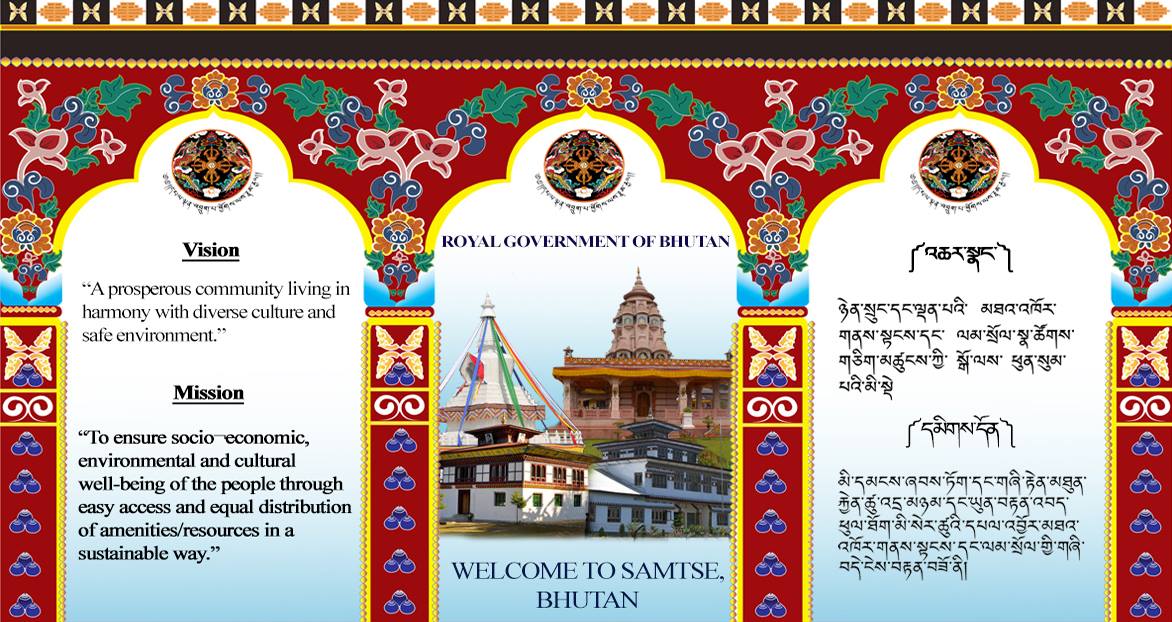
Vision:
"A prosperous community living in harmony with diverse culture and safe environment."
Mission:
“To ensure socio-economic, environmental and cultural well-being of the people through easy access and equal distribution of amenities/resources in a sustainable way.”
History
Prior to the establishment of hereditary monarch in Bhutan, Samtse was divided into two administrative regions, which were eastern and western. The present Norbugang (Chengmari), Ugyentse(Nainital), Yoeseltse(Ghumaunay), Tashicholing(Sipsu), Tendruk, Norgaygang(Bara), Namgaycholing(Lahireni) and Pemaling(Biru) gewogs constituted the western region and were under the control of Gongzin Sonam Tobgay Dorji, the then Raja Sab of Kalimpong. The eastern region comprised of present Samtse, Tading, Pagli gewogs and four gewogs of Dorokha Drungkhag. These were under the administrative control of Dewan and Kazi (Landlords) who were under the direct control of the Paro penlop. The famous Saurini Kothi, which has 52 doors, was used as the summer residence as well as offices of Dewan and Kazi while Dorpani was used as winter residence as well as offices.
During the rule of Dewan and Kazi, every two villages had one Mandal (gup) who were responsible for the collection of rural taxes and other revenues both in cash and kind. Mandals were responsible for enforcement of laws, regulations and solving local disputes. However, issues such as civil as well as criminal cases were directed to Dewan and Kazi, who in turn forwarded to Paro Penlop.
Raja Sab Gongzin Sonam Tobgay Dorji appointed Babu Tshewang Dorji as the first District Commissioner of Samtse in 1950s and Samtse was established as the headquarter of 5 sub-divisional offices viz. Phuntsholing, Kalikhola, Dorokha, Tashicholing and Norbugang.
During 1970s Samtse was created as the Dzongkhag Headquarters and the present administrative unit was established.
Location and area
Until 2005 Samtse Dzongkhag has an area of approximately 1582 square kilometer and has two Dungkhags (Dorokha and Tashicholing) and 16 gewogs. However, in 2006 an area of 194.8 square kilometers (35.91 sq. km. from Dungtoe gewog, 56.13 sq. km. from Namgaycholing gewog, and 102 sq. km. from Mayona gewog.) was handed over to Haa Dzongkhag. The remaining 42.15 sq. km. of Mayona was merged with Dungtoe gewog.
Presently Samtse Dzongkhag has an area of approximately 1309.1 square kilometers and has two Drungkhags (Dorokha and Tashicholing) and 15 gewogs. This gewogs are
- Samtse
- Norbugang
- Ugentse
- Yoeseltse
- Sang-Ngag-Chholing (Chargharey)
- Tading
- Namgaycholing (Lahereni)
- Phuntshopelri (Pagli)
- Tashicholing (Sipsu)
- Norgaygang (Bara)
- Pemaling (Biru)
- Tendruk
- Dungtoe
- Denchukha
- Dorokha
It is bordered by Chukha Dzongkhag in the east, Haa Dzongkhag in the north and the Indian state of West Bengal and Sikkim in the south and west respectively. It has an elevation of 600-800m above sea-level and lies in the subtropical monsoon climate zone with good forest cover. The monthly temperature ranges between 15 degree Celsius in winter to 30 degree Celsius in summer and receives an annual rainfall between 1500-4000 ml. The summer is hot and humid and winter is dry and moderately cool.
Land use and environment
About 64% of the total area is under forest cover and only 8% is under agricultural cultivation. Around 16% of the total area is under the category of others, which includes snow glaciers, eroded lands, water spreads and marshy areas.
In the foothill of Yoeseltse, Ugyentse, Norbugang, Samtse, Tashicholing and Tendruk gewogs, wetland cultivation is an important activity and rice is the staple diet along with mustard as the main oil crop. In the northern gewogs such as Denchukha, Dungtoe and Dorokha, apart from paddy cultivation, the people also depend on dry land cultivation. Maize, Orange and cardamom are also grown extensively.
The main cash crops of Dzongkhag are areca nut, ginger, orange and cardamom. The nearest markets for these crops are the Indian State of West Bengal and the nearby local town. Some cash crops like oranges are even exported to Bangladesh.
People and places.
Samtse has three types of distinct ethnic groups, which are
- Lhotshampas,
- Adibashi and
- Doyaps.
Lhotsampas are immigrants who came to Bhutan in the 1950s from Nepal and nearby Indian towns of Darjeeling and Kalimpong. They speak local dialect as well as ‘Lhotsamkha’. Most of them settled down in the foothill of Yoeseltse, Ugyentse, Norbugang, Tashicholing, and Samtse and also in the gewogs of Dorokha Dungkhag.
‘Doyaps, whose origin is believed to be somewhere from the northern part of Dzongkhag are settled in the villages of Drukpa Bindu, Sengdhen, Lotukuchu Jigme, Lotukuchu Singye and Lotukuchu Wangchuk. They speak their local dialect Lhop.
‘Adibashi’, a group of Indian tribe residing along the southern region of Yoeseltse, Norbugang & Samtse gewogs has originated from nearby Indian towns.
With the start of resettlement programme since 1998-99, people from various Dzongkhags have settled down in the gewogs like Yoeseltse, Ugyentse, Norbugang, Sangngagcholing, Tashicholing, Norgaygang, Dorokha, Denchukha and Namgyacholing.
Festivals:
- Diwali
- Dasain
- Samtse Tshechu
